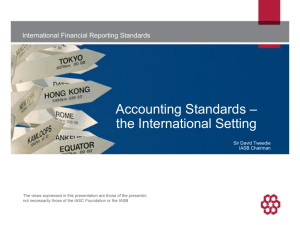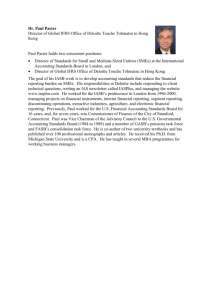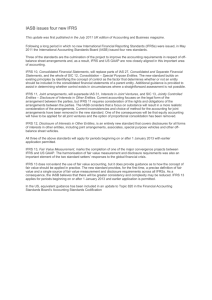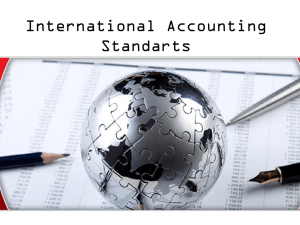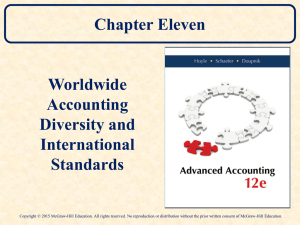regulation - the Business Notes Wiki!
advertisement
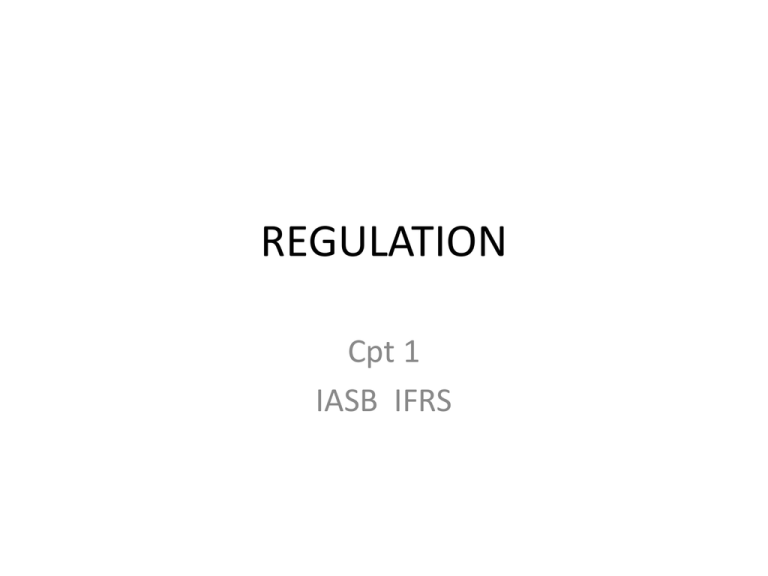
REGULATION Cpt 1 IASB IFRS Reasons for Regulation Motivation for Accounting • IASB = international Standards Board • The objective of general purpose financial reporting is to provide financial information about the reporting entity that is useful to existing and potential investors, lenders and other creditors in making a decision about providing resources to the entity. • Those decisions involve buying, selling or holding equity and debt instruments, and providing or settling loans and other forms of credit. Definition • Financial accounting is a process which is undertaken with the ultimate aim of 1. Identifying 2. Measuring 3. Communicating • Information to the users in order to allow them to make informed decisions. 1. Identify • Book-keeping • Transactions are identified and recorded 2. Measure • Statement of Profit and Loss • Statement of Financial Position 3. Communicate • Financial Statements • Communicating to wide variety of users – Managers, suppliers, financial institutions • Different information needs – Profits, cashflow etc • Management Accounting Vs Financial Accounting • Different Regulatory Environments Management Accounting • Providing detailed information to management • Current performance • Future performance – Projections • Up-to-date • Strategic • Internal Financial Accounting • Preparing financial information for financial statements. – Statement of comprehensive income – Statement of Financial position – Statement of cashflow • Useful to external users • Annual • Historical in nature Management Accounting Regulation • Accepted formats and methods • No obligation to follow the format Financial Accounting Regulation Single body of regulation both professional and statutory Prescribes the preparation and disclosure of accounting information Important for the following reasons: • Fair and accurate representation of the financial position • Allows for better understanding by users • Makes it easier to compare information across companies • Enables better / easier decision making Regulation Regulatory Framework Professional Regulation Internation al Domestic Company Law EU Law Stock Exchange Regulations Domestic Directives Listing Rules International Regulation IASB - IFRS • International Accounting Standards Board • International Financial Reporting Standards IASC IASB Monitoring Board IFRS Foundation Interpretation committee Advisory Council SME Implementation Group IFRS Support Operations Next IASC • Replaced in 2001 by IASB Home IASB • International Accounting Standards Board • Develop a single set of high quality, understandable, enforceable and globally accepted financial reporting standards – Open participatory due process – Engagement with investors, regulators, business leaders and global accountancy profession – Collaborate with worldwide standard setting community – IASB and IFRS, FASB • 9 IFRSs • 29 IASs Home IASB Monitoring Board • The Trustees have established a formal public accountability link to a Monitoring Board of public capital market authorities. • The Monitoring Board's main responsibilities are to ensure that the Trustees continue to discharge their duties as defined by the IFRS Foundation Constitution, as well as approving the appointment or reappointment of Trustees. Home IFRS Foundation • NOT involved in technical matters – do no development of standards etc • 21 trustees appointed by and report to the monitoring board • Appoint members to the IASB, IFRS Advisory council and the IFRS Interpretation Committee • Over see work of IASB – structure, strategy and effectiveness • Consideration of IASB agenda • Establish and amend operating procedures of the IASB, Advisory council and interpretations committee Home • Establish and maintain financing arrangements IFRS Interpretation Committee • 14 Members • Review on a timely basis widespread accounting issues that have arisen within the context of current IFRSs • IFRIC interpretations – published agreements on the treatment of issues – Cover new reporting issues not dealt with in IFRSs – Issues where conflicting interpretations have arisen Home IFRS Advisory Council • Forum for participation by organisations and individuals: 30+ members from national standards setters, preparers, financial analyses, academics, auditors, regulators, investor groups etc • Advise IASB on technical agenda, priorities and timetable • Advise IASB on major standard setting projects • Promotion and adoption of IFRSs Home SME Implementation Group - SMEIG • Support the international adoption of the IFRS for small and medium sized entities = a standard issued in 2009 for the needs of smaller organisations Home IFRS Support Operations • Promotes the IFRS – Creation of XBRL taxonomy = standardised formats and labels which enable the electronic use and exchange and comparability of financial data across companies – Production of training material, workshops and conferences on IFRSs – Promote IFRS brand and global convergence Home IFRS – Standard Setting Process 1 Set Agenda • 6 Steps 6 Review of standards 2 Plan Project 5 Standard 3 Discussion paper 4 Exposure Draft Next 1 Setting the Agenda • Area of financial accounting to be addressed through a standard • IASB consider: – – – – – The relevance of the information to users The reliability of the information provided Existing guidance on the area The quality of the standard developed Whether the new item increases the possibility of convergence – Resource constraints • Consults with IFRS Advisory Council Back 2 Project Planning • May work alone or with other standard setter eg UK ASB or USA FASB • Project team assembled • May request companies to field test a proposed standard • Get feedback and suggestions on alternative treatments of financial transactions Back 3 Discussion Paper • Detailed overview of the issue • Presentation of different potential approaches • Preliminary views of IASB on dealing with issue • Invitation to comment Back 4 Draft Standard • Exposure draft – sets out specific proposal for dealing with an issue. • Based on consideration of comments received on discussion paper, research and suggestions Back 5 Standard • Revision of draft in light of feedback • May go through second exposed draft – eg leasing • Conclusion on treatment of issue • Pre-ballot draft • IFRIC review • IASB ballot • IFRS issued Back 6 Review of Standard • Meetings with interested parties to examine issues relating to practical application of a standard • Alternative interpretations may arise • Revisions may be necessary Back How they Develop Standards Domestic Regulation Four Main Sources of IRISH GAAP 1. 2. 3. 4. Professional Regulation Company Law EU Directives Stock Exchange Regulation GAAP – Generally Accepted Accounting Practices 1. Professional Regulation • Pre 1970s - Institute of chartered accountants in UK – issued accounting guidance - principles to members. • 1970s ASC setup to self regulate – issued Statements of Standard Accounting PracticeSSAPs • Accounting Standards Board ASB replaced ASC 1990s • Issued Financial Reporting Standards-FRSs UK & Ireland • ASB - Accounting Standards Board • SSAPs - Statements of Standard Accounting Practice • FRSs - Financial Reporting Standards • SORPs – Statement of Recommended Practice (For specialist industries such as charities, pensions, insurance, banking etc) • UITF - Urgent Issue Task Force Statements • (Quick guidance on a specific transaction where there is confusion) UK & Ireland • GAAP similar in both • Guidance on contentious accounting issues • Outline the recommended treatment and disclosure of a particular item • Eg inventory – standard details when it should be recognised and the information that should be disclosed • Legal differences do arise – Company legislation – EU directives • Growth in International trade brought the need for international regulation 2. Company Law • Company Acts – Setup – Presentation of Financial Information – Disclosure – Filing in Co Registration Office Company Law - Ireland Size Small Medium Large Statement of Financial Position total up to: €1,904,607 €7,618,428 >€7,618,428 Turnover up to €3,809,214 €15,236,856 >€15,236,856 Average number of employees 50 250 >250 An entity will require that 2 of the 3 criteria be met for 2 consecetive years to fall within a category Disclosure Company Type Content of Financial Statements Small private company limited by shares Auditors report (if applicable) and an abridge/abbreviated Statement of Financial Position Medium private company limited by shares Auditors report, directors report, a Statement of Comprehensive Income (starting at Gross Profit) and a Statement of Financial Position Large Private Company limited by shares Auditors report, directors report, a Statement of Comprehensive Income and a Statement of Financial Position Public company limited by shares Auditors report, directors report, a Statement of Comprehensive Income, a Statement of Financial Position and a Corporate Governance Statement 3. EU Directives 3. EU Directives • Attempted harmonisation across states in 80s and 90s • Time consuming and costly • Now support IASB standards EU Directive • 2002 – companies listed on a regulated market – stock exchange to prepare consolidated financial statements in accordance with international accounting standards by 2005 • Unlisted private companies – SMEs – member states either require or allow them to prepare financial statements in line with international standards EU • EU Adopts IASB standards • Franked for use by EU listed entities • Essential for promoting cross border trade and investment Significance • Largest Capital Markets in USA and UK – companies in neighbouring countries prepare financial statements under same accounting rules and regulations, likely to attract investment • Similarly, EU countries preparing financial statements under same regulation should increase cross border trade • Reduced burden on multinational to produce several financial statements to meet different regulations. Reduces cost and increases trade. 4. Stock Exchange Regulations 4. Stock Exchange Regulations • Apply to companies seeking to float on a regulated market. • Public Limited Companies who issue shares and have shares traded by the public on the stock exchange 4. Stock Exchange Regulations • Regulations are listed in the Stock Exchange Listing Regulations and its Admission of Securities to Listing • Many now contained and expanded upon by professional and statutory requirements • Still contain some important regulations eg Disclosure of price sensitive information to all shareholders at the same time – to eliminate insider trading Purpose of Regulation Fair & True View • Purpose of Accounting and Auditing Regulation is to ensure that financial statements produced and relied upon present a “True and Fair” view of: 1. Financial performance: -Statement of Comprehensive Income 2. Financial position – Statement of Financial position 3. Cash flows – Statement of Cash flow True & Fair • “Fair & True” interpreted as complying with both financial reporting standards and company law • International financial accounting standards refer to a “fair presentation” • “True and Fair Override” is a rare circumstance where an entity doesn’t comply with standards because it would not result in a fair presentation Standards and Law • Financial Reporting Standards tend to deal with how the various figures in the financial statements should be calculated • Company law tends to focus on how the information should be presented to users Standards and Law work together to set standards for Financial statements are true and fair and can be relied upon by users for making economic decisions

